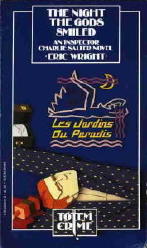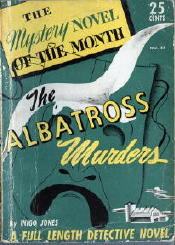June 2007
Monthly Archive
Wed 13 Jun 2007
EVELYN BERCKMAN – Journey’s End.
Avon, paperback reprint; 1st pr., July 1978. Hardcover edition: Doubleday & Co., 1977; first published in UK as Be All and End All, Hamish Hamilton, 1976.

From Twelfth Night:
“Trip no further, pretty sweeting;
Journeys end in lover’s meeting,
Every wise man’s son doth know”
Or possibly (more likely, given the apostrophe) Othello:
“Here is my journey’s end, here is my butt,
And very sea-mark of my utmost sail.”
As for the British title, consider Macbeth, as the leading character is contemplating the killing of Duncan:
“…that but this blow
Might be the be-all and the end-all…
…We’d jump the life to come”
What is also remarkable, in a prescient melancholy sort of way, is that this is Evelyn Berckman’s final novel, written when she was in her late 70s, two or three years before her death in 1978. She did not start writing mystery novels until she was 54 (with The Evil of Time, 1954), but once begun, she averaged a book a year, plus or minus a small fraction.
Having not read any but this one, I can hardly characterize her work in any definitive fashion, but in paperback, at least, her books were often packaged as Gothic Romances, or if not, as Romantic Suspense, with the usual damsel in some sort of distress on the cover.
Since her work was always published in hardcover first, I have a strong hunch that her books had more behind them than that, however, and if you were to go by this book alone, with its strong, in-depth characterizations, the hunch is even stronger. In and of itself, Journey’s End is a melancholy book, filled with melancholy people, with a melancholy ending. Generating most of the plot are a husband and wife who are hired as consultants to evaluate the remnants of an old French woman’s estate.
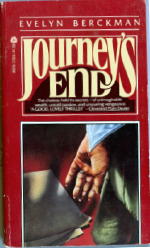
Their marriage is unhappy, however, and perhaps it has never been consummated. The husband is gay, and before his wife arrives, he finds himself head-over-heels madly in love (and in an affair) with a young lad who had been working for the dead woman. That the young lad is also unscrupulous almost goes without saying. If this suggests that the characters seem difficult to sympathize with, it is not so. They are fussily drawn, but that does not make one feel uncharitable toward them, and – somewhat to my own surprise – quite the opposite.
In the midst of the old furniture (all valuable) is a library with hundreds of old documents, dating back to the 1600s. This is a work of criminous fiction, but is there a crime involved? It is difficult to say. On page 123, though, I can tell you this: I sat back and said Wow. (Perhaps I should not tell you anything more definitive than this, and I do not believe I will, but there are some hints hidden in this review.)
Other than this deliberately non-descriptive description, this is a nearly unclassifiable tale, and it’s one that I believe will stick around upside my head for a while.
Here’s a complete bibliography for Evelyn Berckman’s mystery fiction, as taken from Crime Fiction IV, by Allen J. Hubin. US editions only, unless the British titles differ, and in chronological order:
BERCKMAN, EVELYN (Domenica) (1900-1978)
* The Evil of Time (n.) Dodd 1954 [Germany]
* The Beckoning Dream (n.) Dodd 1955. Published as
Worse Than Murder: Dell, pb, 1957.
* The Strange Bedfellow (n.) Dodd 1956. Published as
Jewel of Death: Pyramid, pb, 1968. [Germany]
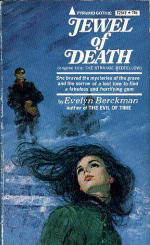
* The Blind Villain (n.) Dodd 1957. Published as House of Terror: Dell, pb, 1960. [Philadelphia, PA]
* The Hovering Darkness (n.) Dodd 1957 [Ship]
* No Known Grave (n.) Dodd 1958
* Lament for Four Brides (n.) Dodd 1959 [France]
* Do You Know This Voice? (n.) Dodd 1960
* Blind Girl’s Buff (n.) Dodd 1962 [England]
* A Thing That Happens to You (n.) Dodd 1964. Published as Keys from a Window: Eyre, UK, 1965.
* A Simple Case of Ill-Will (n.) Dodd 1965 [London]
* Stalemate (n.) Doubleday 1966 [England]
* The Heir of Starvelings (n.) Doubleday 1967 [England]
* -A Case in Nullity (n.) Doubleday 1968. Published as A Hidden Malice: Belmont, pb, 1978. [England]
* The Long Arm of the Prince (n.) Hale 1968 [England; 1600s]
* She Asked for It (n.) Doubleday 1969 [Los Angeles, CA]
* The Voice of Air (n.) Doubleday 1970 [France]
* A Finger to Her Lips (n.) Doubleday 1971 [Germany; 1700s]
* The Fourth Man on the Rope (n.) Doubleday 1972 [England]
* The Stake in the Game (n.) Doubleday 1973
* The Victorian Album (n.) Doubleday 1973 [London]
* Wait, Just You Wait (n.) Doubleday 1974. Previously appeared as Wait: H. Hamilton, UK, 1973. [England]
* The Nightmare Chase (n.) Doubleday 1975. Published in the UK as Indecent Exposure: H. Hamilton, 1975 [England]
* The Crown Estate (n.) Doubleday 1976. Published in the UK as The Blessed Plot: H. Hamilton 1976. [England; 1200s and present]
* Journey’s End (n.) Doubleday 1977. Previously appeared as Be All and End All: H. Hamilton, UK, hc, 1976. [France]
Tue 12 Jun 2007
JOHN J. LAMB – The Mournful Teddy
Berkley 21112; paperback original. First printing: August 2006.
Speaking of cozies, as I was just a book or so ago, take one look at the cover and the title of this book and what would you think? I’ll get back to that in a minute.
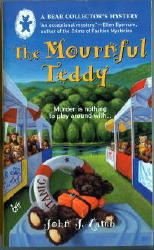
This is the second mystery written by John J. Lamb, a retired homicide detective from San Diego County who pulled up stakes and moved back east to Virginia’s Shenandoah Valley, where he now lives and attends teddy bear shows with his wife, among other activities. His first book, Echoes of the Lost Order (Five Star, hardcover, 2005) sounds as though it might be the first of a totally different series, one that takes place in Talmine, a small Virginia Tidewater town, where a murder is solved by the town’s chief of police, Steve MacKinnon, and his wife, Victoria, a former police crime analyst.
Looking back at that paragraph, I see that I’ve gotten ahead of myself. The Mournful Teddy is already the first in a series, even though it’s the only one that’s been published so far. Coming up in May 2007 is The False-Hearted Teddy, and according to his website, the author is now hard at work on The Crafty Teddy.
And I’m still ahead of myself, or I’ve swung off sideways, and I really have to get back on track. The protagonists in all three of these “Bear Collector’s Mysteries” are retired San Francisco P. D. homicide inspector Brad Lyon and his wife, Ashleigh, a teddy bear collector (and creator), now living along the Shenandoah River in rural Virginia. One senses a pattern at work here.
Which is hardly bad news, and the even better news is that The Mournful Teddy became Number One on the Independent Mystery Bookseller Association’s best-seller list for August 2006. Who among mystery readers can resist a work of detective fiction that involves teddy bears? (When beanie babies were hot hobby items, was there a mystery that involved beanie babies? If not, someone missed a good opportunity, as beanie babies hardly have the mass appeal they had at one time, do they?)

But teddy bears? They never go out of fashion, and I think this series of mysteries that Mr. Lamb has concocted and devised could go on for quite a while. It begins with Lyon finding a body in the Shenandoah outside his home, a male body that the local sheriff and ambulance crew seem to recognize without even turning him over. They also quickly invite Lyon to mind his own business, which of course rankles the retired homicide detective.
Also worked into the tale, as of course you were wondering, is a valuable teddy bear with connections to the Titanic. Make that extremely valuable.
After a slow opening, the story gradually picks up speed, and the antagonistic behavior of the local law enforcement officers gives it an even bigger boost. As an investigator, which he has been for a long time, Lyon is a good interviewer, and he is especially good with hostile witnesses. But even with so many facets to the mystery, it is one that is surprisingly easy to solve, with at least one of the bad guys caving in all too easily and not really (as it turns out) perhaps not that bad at all. Some of them certainly are, however – do not get me wrong – and they are not necessarily all guys, either, in case you were trying to read something into my words that I didn’t mean for you to pick up on.
Overall? Everyone reading this will either (a) read the book or (b) not, no matter what my recommendation might be, so I won’t say anything further, nor do I think I need to.
But here’s a quote from page 88 that I thought was amusing, and since it’s about mysteries, I thought perhaps you might also:
Ash was in bed, her head propped up on a couple of pillows, reading a mystery novel about an amateur sleuth and her talking Pomeranian dog. My wife is a big fan of mysteries, but I’ve never cared for them. In fact, they drive me nuts, because the cops are almost always portrayed as endowed with the brainpower of gravel – the killer is invariably brilliant and erudite, and the perfect murder is solved by a crafty layperson with the assistance of psychic intuition, magic, or an anthropomorphic house pet, for God’s sake.
Ouch. Nothing like that in this one, but still. Ouch.
Mon 11 Jun 2007
Although I’ve yet to hold a copy in my hands myself, Bill Pronzini and Marcia Muller have theirs, and so it’s safe to say that it’s ready for purchase. Ordering information at the bottom of this page.
Originally published in hardcover by Arbor House in 1986, 1001 Midnights by Bill Pronzini and Marcia Muller, one of the finest reference texts ever published in the field of mystery fiction, quickly went out of print, but it has been in high demand in the used book market ever since.
Here’s the blurb on the dust jacket of the original edition, including the list of names on the back cover:
1001 Midnights is the essential reference – and reading – book for all aficionados of mystery, detective, and suspense fiction. It is comprised of 1001 plot summaries, author biographies, and critical evaluations of classic and important crime and espionage novels, as well as short story collections seminal to the genre. It is an indispensable volume of information and criticism.
Bill Pronzini and Marcia Muller, well known for their mystery novels and anthologies, bring their inside, practitioners’ knowledge of the form as well as their enthusiasm as fans to these trenchant and engaging summaries, biographies, and critical judgments. Other experts in the field, most notably Francis M. Nevins, also contribute entries on authors in their areas of expertise.
All the major writers are represented, from Edgar Allan Poe to Elmore Leonard. Their careers and works are described, analyzed, and assessed – sometimes to surprising, irreverent, and unorthodox conclusions. Some highly touted practitioners of the mystery genre have their critical reputations debunked, while others currently out of favor are extolled.
But in addition to the famous names there are numerous obscure writers, and 1001 Midnights is unique and rich as a result of their inclusion. Jim Thompson, Leigh Brackett, Thomas B. Dewey, William Campbell Gault, Helen Reilly, and dozens of others are all resurrected from undeserved obscurity and restored to their rightful place in the crime literature pantheon. In the process, the reader is apprised of great writers he or she may not have heard of but who are well worth seeking out.
Whether you prefer hardboiled or classic, Golden Age or contemporary, pure detection or action/adventure, espionage or private eye, 1001 Midnights will afford hundreds of hours of reading pleasure. It is a book to refer to again and again for its practical information, facts, and bibliographies; its memory-jogging plot summaries; its enlightening critical insights; and its gold mine of newly unearthed crime literature treasures. 1001 Midnights is essential to the library of every mystery buff.
Some of the mystery and suspense writers whose careers and works are included in 1001 Midnights:
Margery Allingham
Eric Ambler
John Franklin Bardin
Earl Der Biggers
Robert Bloch
Lawrence Block
Fredric Brown
James M. Cain
Paul Cain
John Dickson Carr
Raymond Chandler
G .K. Chesterton
Agatha Christie
Mary Higgins Clark
Wilkie Collins
K.C. Constantine
George Harmon Coxe
John Creasey
Carroll John Daly
Len Deighton
Thomas B. Dewey
Arthur Conan Doyle
Daphne DuMaurier
Ken Follett
Frederick Forsyth
Dick Francis
R. Austin Freeman
Jacques Futrelle
Erie Stanley Gardner
William Campbell Gault
Graham Greene
Frank Gruber
Dashiell Hammett
George V. Higgins
Patricia Highsmith
Tonv Hillerman
Evan Hunter
William Irish
P. D. James
M. M. Kaye
Emma Lathen
Jonathan Latimer
John Le Carré
Elmore Leonard
Gaston Leroux
Robert Ludlum
Ed McBain
Horace McCoy
John D. MacDonald
Philip MacDonald
Ross Macdonald
Gregory Mcdonald
William P. McGivern
Charlotte Macleod
Ngaio Marsh
Margaret Millar
A. A. Milne
Frederick Nebel
E. Phillips Oppenheim
Baroness Orczy
Robert B. Parker
Gerald Petievich
Edgar Allan Poe
Melville Davisson Post
Ellery Queen
Ruth Rendell
Mary Roberts Rinehart
Sax Rohmer
Lawrence Sanders
Dorothy L. Sayers
Georges Simenon
Maj Sjöwall and Per Wahlöö
Mickey Spillane
Richard Stark
Rex Stout
Julian Symons
Ross Thomas
Jim Thompson
Dorothy Uhnak
S. S. Van Dine
Robert Van Gulik
Edgar Wallace
Thomas Walsh
Joseph Wambaugh.
Donald E. Westlake
Raoul Whitfield
Phyllis A. Whitney
Cornell Woolrich
And many many others, as they always say.
Published by George Vanderburgh and his Battered Silicon Dispatch Box press, the book is a softcover, folio size, 8-1/2 x 11, with 471 pages. The list price is $45.00. ISBN: 978-1-55246-750-3
The book does not appear on George’s website, but his contact information is there. Otherwise your local specialty mystery bookshop should be able to order it for you.
Highly recommended!
Mon 11 Jun 2007
Posted by Steve under
Authors ,
ReviewsNo Comments
ERIC WRIGHT – The Man Who Changed His Name.
Signet 14930; reprint paperback, August 1987. Hardcover: Charles Scribner’s Sons, August 1986. Canadian editions, both published as A Single Death: Hardcover: Collins, 1987; paperback: Totem, 1987.
[Written shortly after my comments on Eric Wright’s first mystery novel, The Night the Gods Smiled.] If I’d been able to locate copies of the intervening two Charlie Salter mysteries, neither of which I may not actually have, I’d have read one or the other first before tackling this one, the fourth of the series in chronological order. Not that there seems to have been any need to, but I certainly am annoyed at myself for not having access to the two missing books, as I really don’t believe I purchased them when they first came out. I have no record of them, in any case and for what it’s worth, as my collection is completely catalogued only through 1982 or ’83. Both of the two I know I have at present I picked up used, and not so very long ago. Alas, the folly of one’s younger days.
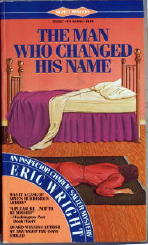
For as much as I enjoyed The Night the Gods Smiled, I enjoyed this one even more, starting immediately from page one onward, beginning with Salter’s first wife calling on him for assistance — in his professional capacity — but after 25 years not seeing each other, it also causes something of a shaking-up to Salter’s semi-insecurity in his present marriage.
Not that the marriage isn’t solid, but Salter is always aware of the differences between his family and Annie’s, especially with Christmas time coming, and both sets of parents coming to visit the Salters at the same time for the first time.
Gerry, Salter’s ex-wife was a free spirit whose life style was 180 degrees incompatible with that of a newly minted young policeman’s. As an author, Eric Wright is excellent (unsurpassed, in fact) in comparing and contrasting differences the way two people act and (try to) live together. It also comes as no surprise to read on and to discover that this is what the case of murder in The Man Who Changed His Name is about, the one that Gerry calls on Charlie for assistance with: that of a lonely woman whose death Gerry, as a middle-aged feminist, feels the police are not taking seriously enough. Separated from her husband many miles away, Nancy Cowell, a social worker, was new to the dating scene, and the police, with no other leads to go one, feel that one of the men she have met while bar-hopping is responsible.
After his wife left him, however, her husband, whose family once changed their name to Cowell, is now known again as Kowalczyk, of Ukrainian lineage, and of course, it has to do something with the story, and so does adultery and jealousy and ethnic relations. (See specifically page 158 for a short but pertinent quote concerning the latter.)
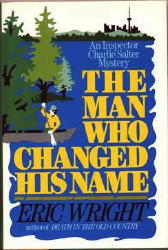
By this far into the series, Salter seems to have found more confidence in himself as an police investigator, and the murder and the trail he follows to solve it is both irresistible and fascinating. Hard-boiled fans may not find too much to get their teeth into, but on the opposite side of the coin, those of you who prefer cozies will find there is far more meat here than you may be accustomed to in your usual diet. What everyone will find, if I’m able to persuade you to pick up a copy, is an abundance of intelligent police work, fashioned and shaped together with a more than an occasional insight into human nature — insight that is brilliant, quietly unerring, and (dare I say) often jarring.
This is an excellent piece of work, from beginning to end. Highly recommended, as if you hadn’t already gathered that yourself.
Mon 11 Jun 2007
My time for the Mystery*File blog will be restricted over the next few weeks, if not for most of the summer, but have no fear. I’m not going away. I have a large archive of book reviews to choose from, many of which have never been published anywhere else, until now. You’ll be seeing them soon.
I also have loads of reviews I did starting back in the 1970s, when they were appearing in both The Mystery FANcier and the Hartford Courant, and (without looking too closely at them yet) I see no reason why I shouldn’t start posting them here too.
You’ll already have noticed the greater frequency of reviews in the past week or so. Most of them have already been written, and the time it takes to get them posted is comparatively minimal. While there’ll always be a steady amount of current mystery fiction that I’ll continue cover, along with the older books and authors, there are any number of mystery-oriented blogs which primarily review and discuss only what’s new and recent. There aren’t as many of them that talk about older books and authors with any degree of regularity, and then within their own selected limits. Maybe I’m simply finding my own niche.
A recent post was called The Compleat INIGO JONES, which I hope you saw, but if not you can always go back and take a look. It’s a format that I like and I think is workable without taking a lot of effort, especially for authors who wrote only a small handful of books before ending their careers, for whatever reason.
If I continue, and I think I will, this series of such short profiles will not be restricted to unknown writers of the 1940s. I’ll cover the gamut. There’s no reason why unknown writers of the 2000s can’t be included, too. Can it really be over seven years since everyone was worried about Y2K? That’s plenty of time for a mystery writer to have come along, produced three or four good books, and then have disappeared again without too much notice — and more crucially, without a contract for more.
I’ll also stay busy working on the online Addenda for Al Hubin’s Revised Crime Fiction IV and uploading covers to the online Supplement to Bill Deeck’s Murder at 3c a Day.
So — without making promises I cannot keep — this is what I will be doing this summer, along with cataloguing and organizing my own collection. I know, I say this every year, but this time I mean it.
Sun 10 Jun 2007
ERIC WRIGHT – The Night the Gods Smiled. Signet 13409; paperback reprint, February 1985. Hardcover edition: Charles Scribner’s Sons, September 1983. Canadian hardcover: Collins, 1983. Canadian paperbacks: Totem (two editions), 1984, 1988.
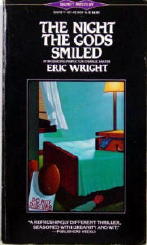
Sub-titled “Introducing Inspector Charlie Salter,” this is the first of ten mysteries solved by Eric Wright’s most well-known series character between 1983 and 1993. An eleventh (and presumably last) case for Salter, a Toronto police detective, appeared in 2002. After first appearing in hardcover, all eleven of them were later published in paperback. When the series was dropped by Signet, the rest were picked up by Canada’s own Worldwide Mysteries (also known as Harlequin).
Wright eventually added a second series character in Mel Pickett, a cop who first played a second fiddle to Salter in A Sensitive Case (1990) and then who tackled one on his own in Buried in Stone (Scribner, 1996), followed by Death of a Hired Man in 2001.
The first of two adventures of Lucy Trimble Brenner also appeared in 1996. Ms. Brenner is a librarian who inherits a Toronto private detective agency and decides to make the big career move. (I have never seen either of the two books, and I think I had better do something about it.)
In the year 2000 a fourth series character came along, a part-time community college English teacher named Joe Barley, who also works part-time as a private eye. He has two books under his belt so far, the second coming out in 2003. The latter may end up being Eric Wright’s final mystery, as he was born in 1929, making him now 77 years old, and perhaps he is no longer writing. Or he may yet surprise us. Perhaps there is yet another in the works.
Eric Wright himself was (and more than likely, in this order) professor, chair of the English department, then Dean of Arts at Ryerson Institute of Technology in Toronto, from where he is now retired. And if his first book (and also more than likely) several of his others deal with academia, one should hardly be surprised. I know I am not, and in fact after reading The Night the Gods Smiled, I highly approve.
The victim, in fact, was a professor of English at a small college in Toronto, but he was found dead in his hotel room while attending an academic conference in Montreal. The dead man’s occupation, however, gives Charlie the opportunity to interview many of his colleagues, none of whom seem to have liked the man very much, some less than others, and in the process, Charlie learns a lot about academic squabbles indeed.
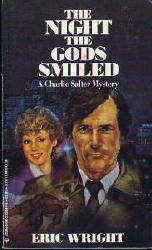
There was a glass with lipstick on it in the dead man’s room. Had he picked up a streetwalker? He had also bragged of good fortune earlier in the day (hence the title). I should back up. Charlie is on the outs with the current administration of the Toronto police force. He works under the category of General Duties, and homicide is by no means his regular assignment. But the investigating officer in Montreal is French, and the roots of the crime may lie in English-speaking Toronto, hence Charlie is assigned liaison duty.
In the background is Charlie’s home life. While they are happily married, there is a class and/or cultural divide between Charlie and his wife (and children) and especially his wife’s family, who are considerably wealthier than Charlie, who gets by on a policeman’s pay, but usually no better than that. That Charlie is (platonically) attracted to the free-spirited Molly, one of the dead man’s students (and so was the professor) is part of who he is and who he is learning himself to be. She is a charmer.
Here’s a short quote taken from a conversation Charlie has with one of the dead man’s colleagues at the Faculty Club, taken from page 59:
“The thing you’ve got to understand, Inspector,” Usher said, causing Salter to hope the others would take him for an inspector of drains, “is that we all have a field. What we specialize in. My field is Lawrence. D.H. I come from Nottingham — did you realize I’m English? — and my grandfather knew Lawrence, or said he did, like most of the old codgers in Nottingham.” Usher broke off again for a sustained maniacal laugh at the lies Nottingham codgers told about Lawrence.
The paragraph is longer, but I’ve changed my mind and decided to cut it off here, omitting the rest of it. The part that I cut has Usher explaining how courses are set up and who gets to teach what course and the like, all of which is necessary for Charlie to feel himself in the dead man’s shoes, and I hope you get the idea well enough from this greatly truncated version.
The following quote shows Wright’s ability to describe something entirely ordinary and everyday, but when you look at it more closely, is not. From page 113:
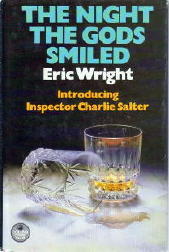
The office of the Dean of Women was open, and Salter pushed the door back and walked in. A secretary looked up from her typewriter, and he introduced himself. She was the drabbest girl he has seen in some time; she looked as though she were hired for her plainness by the original sex-fearing governors of the residence. Her glasses, steel-rimmed, round, and tiny, were balanced on the end of her nose; her thick blonde hair was cut in a straight line, parallel with the bottoms of her ears; she wore a brown smock that looked like a shroud. Salter was appalled and piteous. “Is Miss Homer in?” he asked. “She’s expecting me.”
The girl stood up, took her glasses off, and smiled, transforming herself like the heroine of a musical comedy. She had beautiful teeth, and the shroud, when she was upright, clothed a perfect figure. It’s a style, thought Salter. They do it deliberately.
I have a number of other quotes jotted down to provide to you, but I will resist and behave myself. I also see that I wrote myself a note about the mystery and its solution: “somewhat frazzled at the end but OK.” It’s been a while since I’ve read the book — I’ve had to put off writing this review for several weeks, I’m sorry to say — but I skimmed through the ending again, and I was right. It’s the characters that I remember the most about this book — characters who are described as individuals and (even better) who are allowed to think and behave like human beings that we either know or see around us every day.
The book won a couple of major awards (see below) and if my opinion matters at all, at this late date, I think the author deserved them.
BIBLIOGRAPHY [With a couple of exceptions, these are the US editions only. Some books may have appeared earlier in a Canadian or British edition.]
Charlie Salter:
The Night the Gods Smiled. Scribner, hc, September 1983. (John Creasey Memorial Award, Arthur Ellis Award)
Signet 13409, pb, February 1985.
Smoke Detector. Scribner, hc, December1984.
Signet 14123, pb, February 1986.
Death in the Old Country. Scribner, hc, August 1985. (Arthur Ellis Award)
Signet 14450, pb, 1986.
Signet 14450, 2nd pr., July 1991.
The Man Who Changed His Name. Scribner, hc, August 1986.
Signet 14930, pb, August 1987.
A Body Surrounded by Water. Scribner, hc, December 1987.
Signet 16385, pb, September 1989.
A Question of Murder. Scribner, hc, October 1988.
Worldwide 26039, pb, 1989/90?
A Sensitive Case. Scribner, hc, 1990. [Note: Mel Pickett also appears.]
Worldwide 26083, pb, Oct 1991.
Final Cut. Scribner, hc, May 1991.
Worldwide 26107, pb, Oct 1992.
A Fine Italian Hand. Scribner, hc, 1992.
Worldwide 26143, pb, 1994.
Death by Degrees. Scribner, hc, 1993.
Worldwide 26169, pb, 1995.
The Last Hand. St. Martin’s, hc, February 2002 [in which Salter, having reaching the mandatory retirement age of 60, does exactly that]
Worldwide 26569, pb, 2006.
Mel Pickett:
A Sensitive Case. Scribner, hc, 1990. [Note: A Charlie Salter case in which Pickett also appears.]
Worldwide 26083, pb, Oct 1991.
Buried in Stone. Scribner, hc, March 1996.
Scribner, trade pb, January 2001.
Death of a Hired Man. St. Martin’s, hc, March 2001.
Worldwide 26521, pb, 2005.
Lucy Trimble Brenner:
Death of a Sunday Writer. Foul Play Press, hc, 1996.
Death on the Rocks. St. Martin’s, hc, June 1999.
St. Martin’s, trade pb, June 1999.
Joe Barley:
The Kidnapping of Rosie Dawn. Perseverance Press, hc, 2000. (Barry Award)
Perseverance Press, trade pb, October 2000.
The Hemingway Caper. Castle Street Mysteries (Canada), trade pb, April 2003. No US publication.
Collection:
Killing Climate: The Collected Mystery Stories Eric Wright. Crippen & Landru, trade pb, August 2003. Collection of 16 stories, one original. A limited hc edition also appeared.
“Licensed Guide.” Criminal Shorts, ed. Eric Wright & Howard Engel, Macmillan Canada, 1992
“The Boatman.” [“Start with a Tree”]. Paper Guitar, ed. Karen Muhallen, 1995
“One of a Kind.” Secret Tales of the Arctic Trails, ed. David Skene-Melvin, Simon & Pierre, 1997
“Twins.” A Suit of Diamonds, ed. Anon., Collins, 1990
“Two in the Bush.” Christmas Stalkings, ed. Charlotte MacLeod, Mysterious Press, 1991
“The Duke.” 2nd Culprit, ed. Liza Cody & Michael Z. Lewin, Chatto & Windus, 1993
“Kaput.” Mistletoe Mysteries, ed. Charlotte MacLeod, Mysterious Press, 1989
“Caves of Ice.” EQMM, March 2002
“Hephaestus.” Cold Blood II, ed. Peter Sellers, Mosaic, 1989
“Bedbugs.” Das Magazin, April 26 1996
“Duty Free.” Cold Blood V, ed. Peter Sellers, Mosaic, 1994
“Jackpot.” [“Looking for an Honest Man”]. Cold Blood, ed. Peter Sellers, Mosaic, 1987
“The Cure.” Fingerprints, ed. Beverley Beetham-Endersby, Toronto: Irwin, 1984
“The Lady from Prague.” Cold Blood IV, ed. Peter Sellers, Mosaic, 1992
“An Irish Jig.” The Globe and Mail, December 22, 2001
“The Lady of Shalott.” [Insp. Charlie Salter]. Original.
Lodgings for the Night. Crippen & Landru, August 2003. Separate pamphlet accompanying the limited edition of A Killing Climate: The Collected Mystery Stories by Eric Wright, Crippen & Landru, 2003.
EDITOR: Criminal Shorts: Mysteries by Canadian Crime Writers, ed. Eric Wright & Howard Engel, Macmillan Canada, hc, 1992.
SOURCES:
Allen J. Hubin, Crime Fiction IV.
William J. Contento, Mystery Short Fiction: 1990-2004.
Sun 10 Jun 2007
LESLIE FORD – The Woman in Black
Popular Library K63; reprint paperback, December1963. Hardcover: Charles Scribner’s Sons, May 1947. British hardcover: Collins (Crime Club), 1948. US hardcover reprint: Detective Book Club, 1948 [3-in-1 edition]. Other US paperback editions: Dell #447, mapback, 1950; Popular Library 60-2443, circa 1969. Magazine appearance: The Saturday Evening Post, a seven-part weekly serial from January 18 through March 1, 1947.
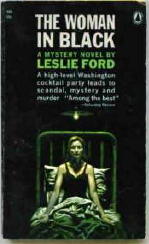
As far as I can recall, this is the first mystery by Leslie Ford that I can recall reading. In doing so, it was with a small amount of bias, shall we say, when I started, having been given negative impressions about her work from others who have read her recently. This negativity was said to lie in Ms. Ford’s attitudes toward racial minorities, but perhaps by 1947, when The Woman in Black was published, this lack of sensitivity had begun to disappear from her work.
Mrs. Grace Latham’s housekeeper Lilac is apparently black, but it is not so stated. The only way you will realize it is from her speech patterns. Here’s a sample, taken from page 19, the first time we meet her in the story. She’s helping to hide a young married woman who has come to Mrs. Latham for some advice:
“You come downstairs with me, child,” she said. She took Susan by the arm. “Mis’ Grace’ll go to the door herself. You settle you’self and come with me.”
By itself I think this is not only fairly innocuous but a pretty good example of a way with words. What the reader gets in these two lines, with no further description, a pretty good picture in his or her mind of who Lilac is and what she may even look like. Is it harmful? Is it demeaning? I’m predisposed to say no, but if you were to press me, I don’t think that it would be too difficult to convince me that any negative stereotyping, wherever or however it occurs, is ever entirely wholesome.
In any case, however, any racial attitudes that are displayed in the author’s earlier books, even done unconsciously, do not manifest themselves in this one to any degree more visibly than this. Not that I’m saying that the case is closed, but I also think that the backgrounds and settings of mystery novels, taken as a snapshot in time, do more to illustrate the attitudes and opinions of everyday people — for better or worse — than any number of history textbooks I ever studied from when I was in school.
Grace Latham, who appeared in many of Ms. Ford’s books, is a widow and apparently a Washington socialite of some stature and renown. She has also made her mark as a sleuth of some distinction, even if only peripherally, as in this one, since the bulk of the real detective work is done by Colonel Primrose’s stalwart assistant, Sergeant Buck, and Captain Lamb of the Washington police department, who also appeared in many of Mrs. Latham’s adventures, but not all.
After retiring from the military, John Primrose and Phineas T. Buck operated in tandem what Grace calls on page 13 a “subterranean private investigation business,” their clients very often being various governmental agencies. Primrose himself does not make an official appearance in this book. He’s quarantined with the measles throughout its duration. Behind the scene, however, he’s actively behind the investigation into the murder that occurs in this case, making numerous suggestions and keeping Grace out of trouble, or trying to.
Dead is a woman who may have been blackmailing a wealthy industrialist who may have his eye on the White House, the blackmailer therefore being in two ways the lady in the title of the book. One of the various people surrounding the would-be presidential candidate, all of whom were at the same cocktail party, is very likely to have been the killer. Most of them are known to Grace, if not close friends, which many of them are, which makes solving the murder all the more difficult for her.
Leslie Ford’s prose is sometimes not easy to read, and sometimes the time and location of where her characters are at any one time seem to be taken too much for granted. The difficulty in reading is also due to a “fretful” way of talking that sometimes seems to bunch itself up too much, making it slow going at times to work one’s way through.
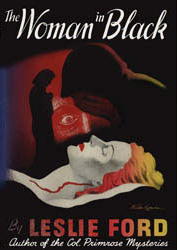
I think the following paragraph, the one quoted at some length below, may go a long way in illustrating this. Grace is with Sergeant Buck, who is trying to reassure her that Susan Kent (the woman being comforted in the quote up above) is not the killer. Grace, by the way, tells the story herself — all but a short Chapter One, which acts like a prologue, which I generally dislike, and once again, yes, I generally dislike it here as well. But to return to page 96, which I was leading up to, before that last digression:
I said, “Thank you, Sergeant.” It didn’t seem to matter, really, that that wasn’t what was worrying me. I was grateful for what seemed to me a surprising mark of confidence from one who’d regarded me as a plain sieve, always to be viewed with the jaundiced and bilious eye of mistrust. But it had never seriously entered my mind that Susan had shot Betty Livingstone, puzzling as it was that she’d known her and actually had been at this house. It wouldn’t make sense, I wondered again, then, about her saying she didn’t know whether she was going to shoot Mr. Stubblefield [the wealthy industrialist] or not. I wished now I hadn’t been so abrupt and had been a little more patient, and found out what she thought she meant, what she had really trying to say when she said it. It seemed very involved and bewildering, and I doubted, with her violent resentment toward me, that I’d ever get a chance to have her clear it up.
Don’t get me wrong, though. Leslie Ford seems to have had an excellent insight into people, why they react the way they do; and into marriages that work, and those that don’t. The mystery element — the whodunit part — is also done in a highly acceptable fashion, all wrapped up in a package that in the end is worth unwrapping. To be completely honest, though, for those willing to stop reading a book that seems unsatisfactory before finishing it, there may easily be doubts along the way.
Sat 9 Jun 2007
As far as my comments about the pseudonymous Inigo Jones are concerned, nothing more has been learned other than was stated in my review of his/her second mystery novel, The Albatross Murders.
Of course, and by now it surely goes without saying, if anything more is learned, odds are you will read about it here first; or if not, I hope it will be no more than second-hand news.
In the meantime, Bill Pronzini has sent along cover scans for both of the Inigo Jones books, which I’ve combined with the information on the titles to be found in Crime Fiction IV, by Allen J. Hubin, and Murder at 3c a Day, by William F. Deeck, and have come up with the following complete crime fiction bibliography for:
INIGO JONES. Pseudonym.
* The Clue of the Hungry Corpse (n.) Arcadia House, hc, 1939. Mystery Novel of the Month #11, digest pb, 1940. Leading characters: Lt. Blanding and Det. Barry Linden, New York Police Department. Setting: New York City.
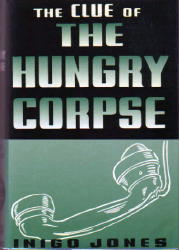
Dust jacket blurb: At 10:07 p.m. Hayden Snell, an eccentric millionaire fond of precious stones almost to the point of madness, is found dead in his overheated study, a Japanese dagger thrust hilt-deep in his heart. Temperature of the room makes it impossible to determine exact time of death, but his telephone receiver was removed at exactly 9:15 p.m.
Involved in this crime and the complicated network of mystery and adventure that follows are: Katherine Fox, grand-niece of the deceased, the only suspect who cannot provide a satisfactory alibi; Arthur Leader, natural son who hates the entire Snell family; Evander Snell, middle-aged son who mortally fears his sister Miriam; Joseph Rogato, shady private investigator, who tries to have himself arrested for the crime; Weisswasser, Rogato’s mouthpiece and partner in crime; Cokey Flo, Arthur’s mother, who has information implicating Evander Snell in an earlier crime; Monk Saunders, her husband, who holds a powerful threat over Rogato.
A satisfying detective story particularly recommended to those who appreciate good writing and a complicated puzzle.
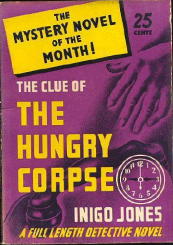
Review excerpts: [Will Cuppy, Books.] The author’s writing manner, except for a few backslidings into fancy prose, struck us as a cut above the standardized brittle style now employed by most of the ribald school, and his criminous lingo is inspired. Try the pseudonymous Mr. Jones for amusing wickedness.
[Kay Irwin, New York Times.] There is a little of everything in this story; it is a hodge-podge of excitements, inexpertly handled.
The unanswerable question is why the architect of such a gingerbread structure chooses to sign himself “Inigo Jones.”
[Saturday Review of Literature.] Couple of clever tricks explained at end, but characters are overdrawn and plot pretty phoney. Not so much.
* The Albatross Murders (n.) Mystery House, hc, 1941. The Mystery Novel of the Month #33; digest pb, 1941. Leading character: Inspector Sebastian Booth. Setting: New England; Theatre.
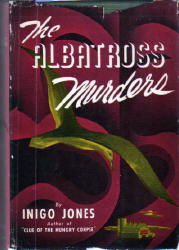
Dust jacket blurb: During ten months of the year Shrewsbury was — on the surface — a quiet little New England town; for two months it was something else again.
For then the summer theatre brought its freight if small-time Broadway talent and amateur aspirants. Their jealousies and conflicts met in a fateful dovetail with conflicts and motives buried deep in Shrewsbury’s past. And so murder struck.
One died in the sight of five hundred, another died alone. Meanwhile the promise of death murmured everywhere.
With a fleck of paint off a three-hundred year-old chimney and the aid of twentieth-century science; with the bones of a praying Indian and a bird that flew by night; with an antique silver smelling-salts bottle and a scandal that had its roots in another age and clime — with the aid of these and other things Inspector Sebastian Booth at length solved this dark puzzle of fate’s irony and bloody vengeance.
Review excerpt: [New York Times.] …Finally Booth comes up with a theory that accounts for everything. The only trouble is that there is very little evidence to support it. It is not a very satisfactory ending, but it is the best that Inigo Jones has to offer.
Sat 9 Jun 2007
Posted by Steve under
Authors[13] Comments
Jon Paul Morgan, the author of the article on “Zeno,” from which most of the information in the previous blog entry on the pseudonymous author and convicted killer was taken, has his own blog site where you can read the piece in its entirety.
This result of a long investigation first appeared in Punch magazine. All of the details — only touched on before — are in the article, along with a number of photos. (Click on the pages to make them readable.)
It’s a fascinating story, and hats off to Jon Paul Morgan. For doing the research he did and writing it up, he’s earned the credit .
Thu 7 Jun 2007
CHARLES J. DUTTON – The Clutching Hand
A. L. Burt; hardcover reprint, no date stated [1929]. First Edition: Dodd Mead & Co., 1928.
It does no harm, I don’t imagine, to begin with a list of Dutton’s mystery novels. Taken from Crime Fiction IV, by Allen J. Hubin, the one that follows is in chronological order, and does not include British editions.
DUTTON, CHARLES J(udson) (1888-1964)
* The Underwood Mystery (n.) Dodd 1921 [John Bartley; Connecticut]
* Out of the Darkness (n.) Dodd 1922 [John Bartley; New York]
* The Shadow on the Glass (n.) Dodd 1923 [John Bartley; Rhode Island]
* The House by the Road (n.) Dodd 1924 [John Bartley; Vermont]
* The Second Bullet (n.) Dodd 1925 [John Bartley; New England]
* The Crooked Cross (n.) Dodd 1926 [John Bartley; New York]
* Flying Clues (n.) Dodd 1927 [John Bartley; New England]
* The Clutching Hand (n.) Dodd 1928 [John Bartley; Connecticut]
* Murder in the Dark (n.) Brentano’s 1929
* Streaked with Crimson (n.) Dodd 1929 [Harley Manners; New England]
* The Shadow of Evil (n.) Dodd 1930 [Harley Manners; U.S. Midwest]
* Murder in a Library (n.) Dodd 1931 [Harley Manners]
* Poison Unknown (n.) Dodd 1932 [Harley Manners; New York]
* The Circle of Death (n.) Dodd 1933 [Harley Manners]
* Black Fog (n.) Dodd 1934 [Harley Manners; New England]
Dutton did other writing as well as mysteries, including a biography of Oliver Hazard Perry in 1935, a book that’s apparently still in print, and a book entitled The Samaritans of Molokai: The Lives of Father Damien and Brother Dutton Among the Lepers. (Joseph Dutton worked as a Catholic lay missionary at Kalaupapa, Molokai Island, Hawaii. He arrived on Molokai in 1886, working with Father Damien until Damien’s death in 1889, and remaining on the island until the time of his own death in 1931.)
Of Harley Manners, I know nothing. Of John Bartley, The Clutching Hand represents the final of nine appearances, and in all honesty, it is not an impressive outing. His companion on this case, a man named Pelt, says of him, taken from pages 2-3:
Though for many years Bartley had been considered the most noted criminologist of the country, yet for many years he had been going into what might be called semi-retirement. There were several reasons for this — reasons which were not surprising if one only knew his background and his personal inclinations.
First of all, he wished to find time to write books — books for which he had been gathering materials for years. [ … ]
But there was also another reason why his name had not appeared in the papers for many months. Crime had changed, he said. That there was more crime now that ever before he would agree, but the class of criminals had changed with the increase in crime. Youths crazed by poor liquor, or their courage whipped for a moment by cocaine, were now our murderers and lawbreakers, and for an intelligent man the game was hardly worthy of the chase.
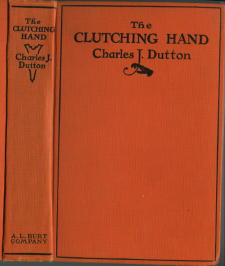
This, however, is primary a case (no pun intended) of tell but not show. Here’s another excerpt, this one from page 122, after the case of the clutching hand has begun in earnest. Bartley is talking:
“We all have the opinion, Miner, that in every murder we must have some clue, as you put it, before we can solve the crime. That is correct, but not in the way you think. Scotland Yard, for instance, does not build up a theory about a crime from a clue alone. They investigate hundreds of small things, throw out what they do not need, keep what is of value. It is like a puzzle. You fit together hundreds of little bits of wood before the design becomes clear. So with a crime of this type. It means the gathering together of many things before we can say who is the guilty party, or why it happened.”
“But we do not have even a theory,” was the retort.
“At present a theory is the last thing we wish,” was Bartley’s answer. “In too many cases the police start with a theory, and then they try to fit every fact to it. We will have our theory of the crime after we have been able to arrange and discard certain facts which will come out. Just now we have no theory at all, that is one which we must make every fact fit into.”
The doctor gave a little laugh, then assured us we knew one fact — that Van Dike was dead, and that he had been murdered.
The murder had occurred — to back up just a little — on a dreary, rain-drenched outpost of an island in Long Island Sound. Van Dike was a famed criminal lawyer with many enemies. After Bartley and Pelt had found the body along in a car, and with Pelt waiting alone for Bartley to return with the authorities, the death apparently (at first) a suicide, Pelt spies a hand reaching into the window to clutch at the dead man’s coat. He gives chase, but loses whoever it was in the mist along the shore.
It was “a lonely place on a dark rainy night.” The very words are found on page 105.
It’s hard to say too much about Bartley’s abilities as a detective. He does have the answers at the end of the book, but he does not confide much in Pelt, a man who — and I do hate to say this — is as dumb as a stump. He takes in each day, or so it seems, with the countenance of a new-born babe.
Clues are not so much found (see the quote above) as, well, here’s an example. On page 123, all seems lost, as far as the investigation is concerned. “So far we knew nothing,” Pelt tells us, the reader, “not the slightest thing of value. And I wondered if we would ever know anything.”
The chief of police, in attendance at this meeting of minds, pauses and pondering this, says, “I found out one thing which seems odd.” As if it happened to casually occur to him at that very moment, and of course it is exactly what is needed to generate another burst of major barnstorming on the case. Everything seems to happen in slow motion, including a trip by Pelt to a nearby island to visit a gambler’s den there, a trip long in detail, but not much is made of it later on.
There is a woman named Lura who is involved, and so are some letters. Could it be the same Lura, a woman who also lives on the island? Pelt is greatly puzzled over the possibility that the two could be one and the same. You would think that Lura were as common a woman’s name as Lorraine or Linda.
The case concludes with a confrontation with the killer, with Bartley outlining the case against him in hypothetical fashion. It is a solid case, an iron-clad one, but Pelt is amazed, absolutely stunned when he/she in fact really turns out to be the killer. From page 287, Pelt says to the reader:
Astounded, I had sunk back in my chair. It could not be possible; it was absurd that […] should say [
he/she ] had killed Van Dike. And yet, I remembered the conversation. […]
Or perhaps this was meant to be the double-switcheroo of an ending, but no, not so. Bartley was no Ellery Queen, and Pelt is no Watson.
« Previous Page — Next Page »












